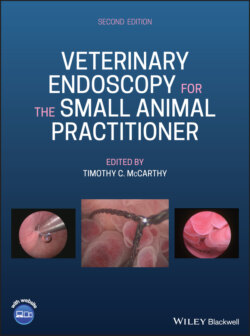Читать книгу Veterinary Endoscopy for the Small Animal Practitioner - Группа авторов - Страница 27
2.2.6.2 Vessel Sealing Devices
ОглавлениеSystems capable of sealing larger blood vessels, up to 7 mm diameter, were developed for minimally invasive surgery use in human patients. These devices use tissue fusion technology that applies low voltage with high current across a bipolar instrument while measuring tissue impedance (resistance) to achieve a tissue weld sealing the blood or lymphatic vessel. The original vessel sealing device using this technology was the LigaSure and has been the workhorse in small animal practice for over 20 years. Originally introduced for minimally invasive surgery with sealing and cutting capability in one instrument, it also became a standard instrument for open surgery with handpieces developed specifically for open surgery. A second‐generation device produced by the same company and the standard today is the ForceTriad (Figure 2.14) with advanced technology for faster function but little change in sealed vessel properties. The ForceTriad also has monopolar and bipolar modules. A wide variety of instruments are available for minimally invasive surgery in 5 and 10 mm diameters (Figure 2.15) and in lengths from 20 to 37 cm with sealing and cutting capabilities. There is also selection of open surgery instruments just for sealing (Figure 2.16) and sealing plus cutting in one instrument (Figure 2.17). A third‐generation device is now available, but this step has incorporated circuitry to prevent reuse of the handpieces currently making it unsuitable for small animal practice. The company has indicated that they are working on a modification to allow reuse of the handpieces in veterinary medicine. Competing companies have developed similar vessel sealing devices that are now available and are worth considering for use in small animal practice.
Figure 2.14 The ForceTriad vessel sealing device with standard monopolar radiofrequency on the left, monopolar or bipolar radiofrequency in the center, and vessel sealing on the right side of the control box. All three modalities can be connected and active simultaneously.
(Source: Photo courtesy of Covidien Division of Medtronic's.)
Figure 2.15 A 10 mm diameter 37 cm long “Atlas” vessel sealing instrument for minimally invasive surgery with a round shaft to provide a seal for maintaining insufflation during laparoscopy. This is the workhorse for minimally invasive surgery in small animal practice. Multiple‐length 10 mm instruments and similar 5 mm diameter instruments are available for use with this system.
(Source: Photo courtesy of Covidien Division of Medtronic's.)
Figure 2.16 An open‐surgery handpiece for use with the ForceTriad that seals but does not cut.
(Source: Photo courtesy of Covidien Division of Medtronic's.)
Figure 2.17 An open‐surgery handpiece for use with the ForceTriad that seals and cuts in one instrument.
(Source: Photo courtesy of Covidien Division of Medtronic's.)
